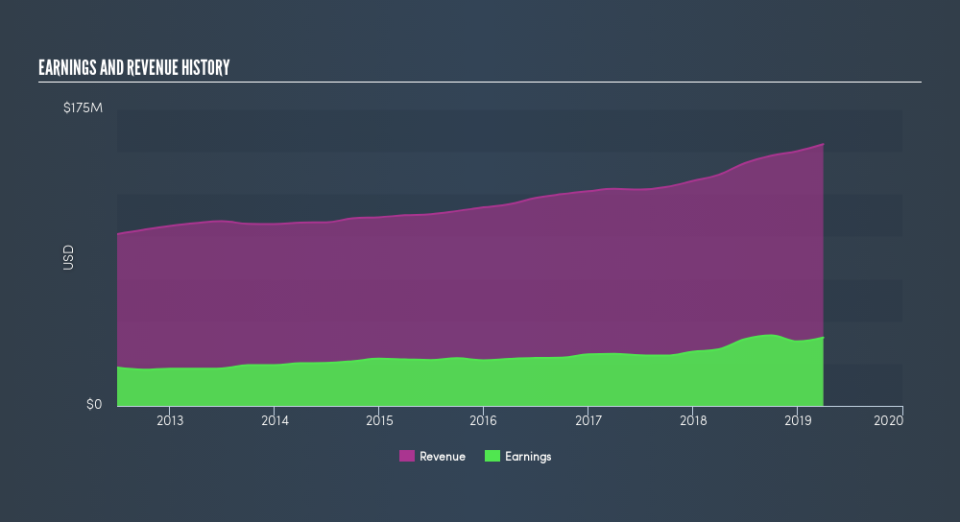Do Financial Institutions's (NASDAQ:FISI) Earnings Warrant Your Attention?

Want to participate in a short research study? Help shape the future of investing tools and you could win a $250 gift card!
For beginners, it can seem like a good idea (and an exciting prospect) to buy a company that tells a good story to investors, even if it completely lacks a track record of revenue and profit. Unfortunately, high risk investments often have little probability of ever paying off, and many investors pay a price to learn their lesson.
In the age of tech-stock blue-sky investing, my choice may seem old fashioned; I still prefer profitable companies like Financial Institutions (NASDAQ:FISI). While that doesn't make the shares worth buying at any price, you can't deny that successful capitalism requires profit, eventually. In comparison, loss making companies act like a sponge for capital - but unlike such a sponge they do not always produce something when squeezed.
See our latest analysis for Financial Institutions
Financial Institutions's Earnings Per Share Are Growing.
The market is a voting machine in the short term, but a weighing machine in the long term, so share price follows earnings per share (EPS) eventually. Therefore, there are plenty of investors who like to buy shares in companies that are growing EPS. Financial Institutions managed to grow EPS by 9.0% per year, over three years. That growth rate is fairly good, assuming the company can keep it up.
I like to see top-line growth as an indication that growth is sustainable, and I look for a high earnings before interest and taxation (EBIT) margin to point to a competitive moat (though some companies with low margins also have moats). Not all of Financial Institutions's revenue this year is revenue from operations, so keep in mind the revenue and margin numbers I've used might not be the best representation of the underlying business. Financial Institutions maintained stable EBIT margins over the last year, all while growing revenue 13% to US$154m. That's progress.
In the chart below, you can see how the company has grown earnings, and revenue, over time. To see the actual numbers, click on the chart.
Fortunately, we've got access to analyst forecasts of Financial Institutions's future profits. You can do your own forecasts without looking, or you can take a peek at what the professionals are predicting.
Are Financial Institutions Insiders Aligned With All Shareholders?
Like standing at the lookout, surveying the horizon at sunrise, insider buying, for some investors, sparks joy. That's because insider buying often indicates that those closest to the company have confidence that the share price will perform well. Of course, we can never be sure what insiders are thinking, we can only judge their actions.
Any way you look at it Financial Institutions shareholders can gain quiet confidence from the fact that insiders shelled out US$490k to buy stock, over the last year. When you contrast that with the complete lack of sales, it's easy for shareholders to brim with joyful expectancy. It is also worth noting that it was Senior VP and Chief Customer Experience & Go to Market Officer of Five Star Bank Joseph Dugan who made the biggest single purchase, worth US$302k, paying US$28.45 per share.
Along with the insider buying, another encouraging sign for Financial Institutions is that insiders, as a group, have a considerable shareholding. To be specific, they have US$20m worth of shares. That shows significant buy-in, and may indicate conviction in the business strategy. Despite being just 4.6% of the company, the value of that investment is enough to show insiders have plenty riding on the venture.
While insiders already own a significant amount of shares, and they have been buying more, the good news for ordinary shareholders does not stop there. That's because on our analysis the CEO, Marty Birmingham, is paid less than the median for similar sized companies. I discovered that the median total compensation for the CEOs of companies like Financial Institutions with market caps between US$200m and US$800m is about US$1.8m.
Financial Institutions offered total compensation worth US$1.1m to its CEO in the year to December 2018. That comes in below the average for similar sized companies, and seems pretty reasonable to me. CEO compensation is hardly the most important aspect of a company to consider, but when its reasonable that does give me a little more confidence that leadership are looking out for shareholder interests. I'd also argue reasonable pay levels attest to good decision making more generally.
Should You Add Financial Institutions To Your Watchlist?
One positive for Financial Institutions is that it is growing EPS. That's nice to see. On top of that, we've seen insiders buying shares even though they already own plenty. That makes the company a prime candidate for my watchlist - and arguably a research priority. Of course, just because Financial Institutions is growing does not mean it is undervalued. If you're wondering about the valuation, check out this gauge of its price-to-earnings ratio, as compared to its industry.
The good news is that Financial Institutions is not the only growth stock with insider buying. Here's a a list of them... with insider buying in the last three months!
Please note the insider transactions discussed in this article refer to reportable transactions in the relevant jurisdiction
We aim to bring you long-term focused research analysis driven by fundamental data. Note that our analysis may not factor in the latest price-sensitive company announcements or qualitative material.
If you spot an error that warrants correction, please contact the editor at editorial-team@simplywallst.com. This article by Simply Wall St is general in nature. It does not constitute a recommendation to buy or sell any stock, and does not take account of your objectives, or your financial situation. Simply Wall St has no position in the stocks mentioned. Thank you for reading.

